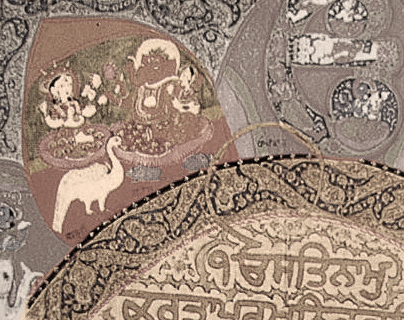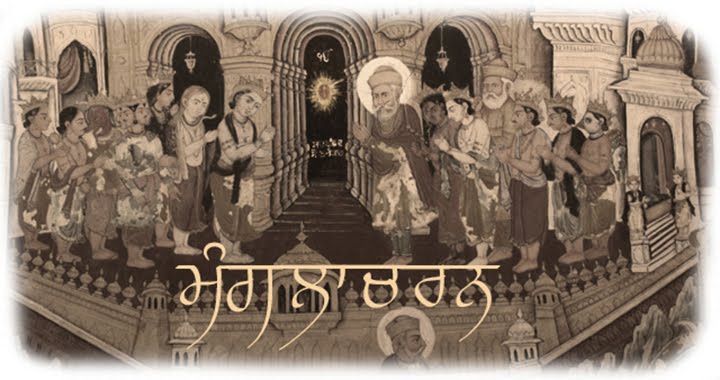"Hail to the son of Shiva [Ganesh]" - Sarbloh Granth
1:40 AM |
| A 18th century Adi Guru Granth Sahib manuscript with a Ganesh image on the first page |
॥ ਛਪਯ ਛੰਦ ॥ ਗਨਪਤਿ ਗੌਰੀ ਸੁਤ ਭਜਹੁ ਰਿਧਿ ਸਿਧਿ ਕੋ ਧਾਮ ॥
Worship the Master of the servants to Shiva, son of Parbati, and the house of all Ridh Sidh [mystical powers].
ਸੁਖ ਪਾਵਹੁ ਨਿਤ ਨਿਤ ਸਦਾ ਧਨ ਪਾਵਹੁ ਬਿਸ੍ਰਾਮ ॥
Forever bless me with happiness always, along with wealth and rest.
ਏਕ ਰਦਨ ਗਜ ਬਦਨ ਸਦਨ ਗੌਰੀ ਸੁਖ ਨੰਦਨ ॥
The one with One Tooth, the face of an Elephant, sitting [in the house of] Parbati as her son giving happiness [to all].
ਬੁਧਿ ਦਾਇਕ ਅਘ ਹਰਨ ਸਦਾ ਸੁਰ ਕਿਲਵਿਖ ਖੰਡਨ ॥
Giver of intellect, destroyer of pain, forever the destroyer of the Angels' [Demigods/Devtiyan] sins.
ਸੁਬੁਧਿ ਗ੍ਯਾਨ ਦਾਤਾ ਹਰੀ ਅਘ ਪਾਪ ਨਿਕੰਦਨ ॥
Giver of great intellect, Oh Hari and destroyer of sins.
ਗਨਪਤਿ ਗੌਰੀ ਦੇਵਿ ਸੁਤ ਜੈ ਜੈ ਸਿਵ ਨੰਦਨ ॥
The Master of the servants of Shiva, son of Parbati, Hail Hail to the son of Shiva [Ganesh].
Sarbloh Granth, Volume I, page 23
ਸਰਬਲੋਹ ਗ੍ਰੰਥ, ਭਾਗ ਪਹਿਲਾ, ਪੰਨਾ 23
-------
Upon reading this passage from Sarbloh Granth, one might question the scripture based on Guru Gobind Singh Ji's passage from a section called 'Devi Ji Ki Ustat':
ਮੈ ਨ ਗਨੇਸ਼ਹਿ ਪ੍ਰਿਥਮ ਮਨਾਊਂ ॥ ਕਿਸ਼ਨ ਬਿਸ਼ਨ ਕਬਹੂੰ ਨਹ ਧਿਆਊਂ ॥
I do not remember Ganesha at the start of tasks, nor do I ever contemplate upon Krishna or Vishnu.
However this contrast of perspective is nothing new in Gurmat. Depending upon the Sarguna or Nirguna perspective adopted in the poetry, different stances will appear. They are not contradictory, just as looking upon a tree with ones eyes is different than looking at the tree with a microscope. Both will appear differently, yet both are acceptable and not false.
Similar instances occur within Adi Guru Granth Sahib when talking about Krishna.
ਨ ਸੰਖੰ ਨ ਚਕ੍ਰੰ ਨ ਗਦਾ ਨ ਸਿਆਮੰ ॥
[Paramatmaa] has no conch-shell, no religious mark, no Mace, and is not dark coloured.
ਅਸ੍ਚਰਜ ਰੂਪੰ ਰਹੰਤ ਜਨਮੰ ॥
[Paramatmaa]'s form is [simply] Wondrous and is without incarnation.
- ਆਦਿ ਗੁਰੂ ਗ੍ਰੰਥ ਸਾਹਿਬ ਜੀ, ਅੰਗ 1359
Adi Guru Granth Sahib Ji, Page 1359
Yet in the Bhattan Di Svaiyay, it describes Paramatmaa in the Sarguna form of Krishna as follows:
ਸੰਖ ਚਕ੍ਰ ਗਦਾ ਪਦਮ ਆਪਿ ਆਪੁ ਕੀਓ ਛਦਮ ਅਪਰੰਪਰ ਪਾਰਬ੍ਰਹਮ ਲਖੈ ਕਉਨੁ ਤਾਹਿ ਜੀਉ ॥
You are the one holding the conch-shell, the mace and lotus [Krishna], and You yourself deceived [Baliraja as Bavan Avatar], Oh Limitless Par-brahm, who can know your true extent?
ਸਤਿ ਸਾਚੁ ਸ੍ਰੀ ਨਿਵਾਸੁ ਆਦਿ ਪੁਰਖੁ ਸਦਾ ਤੁਹੀ ਵਾਹਿਗੁਰੂ ਵਾਹਿਗੁਰੂ ਵਾਹਿਗੁਰੂ ਵਾਹਿ ਜੀਉ ॥੨॥੭॥
Truely you are the Changeless Form and caretaker of Lakshmi, From the beginning and forever [true] You are, Vahiguru Vahiguru Vahiguru Vah Ji.
- ਆਦਿ ਗੁਰੂ ਗ੍ਰੰਥ ਸਾਹਿਬ ਜੀ, ਅੰਗ 1402
Adi Guru Granth Sahib Ji, 1402
The following post will be from Vichar Sagar, which will demonstrate the Nirguna perspective very clearly. A standard in the curriculum of Taksals and Sampradyas for traditional scriptural learning; its main focus is dealing with the sophisticated perspective of Advaita [non-dualism].


0 comments